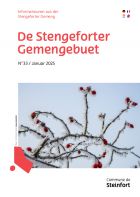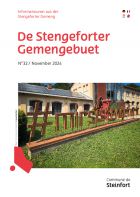De Gemengebuet N°36 November 2025
Nombre de téléchargement: 10
English version Eng gutt Nues fir den Aartenschutz (p.16)
Fine noses for species protection
Mapping plants and animals using scent detection dogs has become a new promising approach in the field of nature and species conservation. Particularly the case for tree inhabiting bats, the dog’s nose trained to bat scats may detect any kind of bat roosts simply from the ground. Whereas the extraordinary sense of smell of dogs is well known, the real art lies in conditioning dogs and learning to indicate specific scents. A skill which has already been taught since several years by the two project partners, the dog training centre “Spürnasenarbeit” as well as the environmental study office “MKEcology”. After systematically having scanned a certain forested study area, active tree roosts can be easily identified. The aim of the project, which is financed by the environmental fund, is to efficiently identify tree roosts so that they can be marked and preserved as so-called biotope trees or within old-growth areas during forest management. The designation of these biotope trees and old growth areas for bat conservation constitutes an important operational measure for the management plan of the local habitat site „Faascht“.
Forest-dwelling bats inside of the Habitat site Faascht
The habitat site „Faascht“, a forest massif located southeast of Steinfort and part of the Natura 2000 steering committee „Mamer-Eischtal-Grünewald“, comprises a diverse deciduous forest with high structural diversity and an old stand age. Besides distinct forest edges and clearings, the stands here are interspersed with plenty of deadwood and older habitat trees. Water collects in numerous depressions on the heavy clayey soils, forming pools. The oak-hornbeam forests, some of which are up to 140 years old, are particularly valuable from an ecological perspective and provide important habitats for various forest-dwelling bat species at the regional level. Both the Greater mouse-eared bat (Myotis myotis) and the Bechstein’s bat (Myotis bechsteinii), two species listed in the Annex 2 of the Habitats Directive (92/43/EEC), occur here. In addition, six other species of the order of the Chiroptera have been recorded, including the Brown and Grey long-eared bat (Plecotus auritus, Plecotus austriacus), the Brandt’s bat (Myotis brandtii), the Natterer’s bat (Myotis nattereri), the Alcathoe bat (Myotis alcathoe) as well as the common pipistrelle (Pipistrellus pipistrellus). Some of these species use the forest area with its many microhabitats primarily as a feeding habitat, while others find suitable crevices and cavities in the numerous old oak trees as nursery colonies for reproduction. The latter is particularly true of Bechstein's bat. Since both the exact locations of these tree roosts and the usage patterns of tree-dwelling bat species are unknown, the precise localisation of existing colonies is key to their protection in the field. As part of the study, 41 trees have been detected so far in an area of 10 hectares. In the further course of the pilot project, the trees indicated by the dog will be climbed during the winter months to check occupancy and validate the new method.
Further information about this project as well as other activities of the Natura 2000 steering committee « Mamer-Äischdall-Gréngewald » can be found here : www.natura2000.lu



















